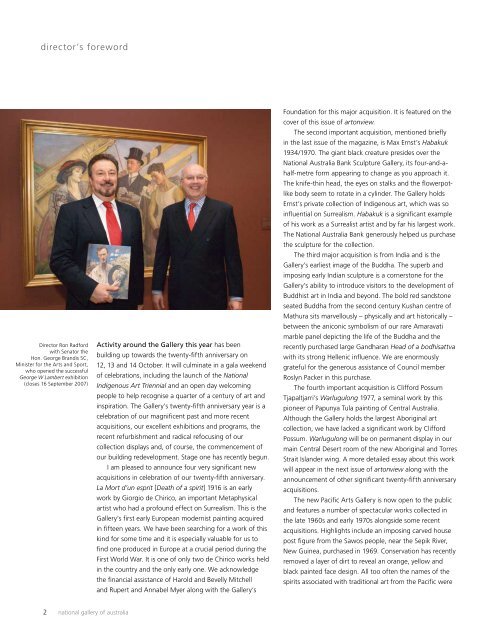Art Ew - National Gallery of Australia
Art Ew - National Gallery of Australia
Art Ew - National Gallery of Australia
You also want an ePaper? Increase the reach of your titles
YUMPU automatically turns print PDFs into web optimized ePapers that Google loves.
director’s foreword<br />
Director Ron Radford<br />
with Senator the<br />
Hon. George Brandis SC,<br />
Minister for the <strong>Art</strong>s and Sport,<br />
who opened the successful<br />
George W Lambert exhibition<br />
(closes 16 September 2007)<br />
2 national gallery <strong>of</strong> australia<br />
Activity around the <strong>Gallery</strong> this year has been<br />
building up towards the twenty-fifth anniversary on<br />
12, 13 and 14 October. It will culminate in a gala weekend<br />
<strong>of</strong> celebrations, including the launch <strong>of</strong> the <strong>National</strong><br />
Indigenous <strong>Art</strong> Triennial and an open day welcoming<br />
people to help recognise a quarter <strong>of</strong> a century <strong>of</strong> art and<br />
inspiration. The <strong>Gallery</strong>’s twenty-fifth anniversary year is a<br />
celebration <strong>of</strong> our magnificent past and more recent<br />
acquisitions, our excellent exhibitions and programs, the<br />
recent refurbishment and radical refocusing <strong>of</strong> our<br />
collection displays and, <strong>of</strong> course, the commencement <strong>of</strong><br />
our building redevelopment. Stage one has recently begun.<br />
I am pleased to announce four very significant new<br />
acquisitions in celebration <strong>of</strong> our twenty-fifth anniversary.<br />
La Mort d’un esprit [Death <strong>of</strong> a spirit] 1916 is an early<br />
work by Giorgio de Chirico, an important Metaphysical<br />
artist who had a pr<strong>of</strong>ound effect on Surrealism. This is the<br />
<strong>Gallery</strong>’s first early European modernist painting acquired<br />
in fifteen years. We have been searching for a work <strong>of</strong> this<br />
kind for some time and it is especially valuable for us to<br />
find one produced in Europe at a crucial period during the<br />
First World War. It is one <strong>of</strong> only two de Chirico works held<br />
in the country and the only early one. We acknowledge<br />
the financial assistance <strong>of</strong> Harold and Bevelly Mitchell<br />
and Rupert and Annabel Myer along with the <strong>Gallery</strong>’s<br />
Foundation for this major acquisition. It is featured on the<br />
cover <strong>of</strong> this issue <strong>of</strong> artonview.<br />
The second important acquisition, mentioned briefly<br />
in the last issue <strong>of</strong> the magazine, is Max Ernst’s Habakuk<br />
1934/1970. The giant black creature presides over the<br />
<strong>National</strong> <strong>Australia</strong> Bank Sculpture <strong>Gallery</strong>, its four-and-ahalf-metre<br />
form appearing to change as you approach it.<br />
The knife-thin head, the eyes on stalks and the flowerpotlike<br />
body seem to rotate in a cylinder. The <strong>Gallery</strong> holds<br />
Ernst’s private collection <strong>of</strong> Indigenous art, which was so<br />
influential on Surrealism. Habakuk is a significant example<br />
<strong>of</strong> his work as a Surrealist artist and by far his largest work.<br />
The <strong>National</strong> <strong>Australia</strong> Bank generously helped us purchase<br />
the sculpture for the collection.<br />
The third major acquisition is from India and is the<br />
<strong>Gallery</strong>’s earliest image <strong>of</strong> the Buddha. The superb and<br />
imposing early Indian sculpture is a cornerstone for the<br />
<strong>Gallery</strong>’s ability to introduce visitors to the development <strong>of</strong><br />
Buddhist art in India and beyond. The bold red sandstone<br />
seated Buddha from the second century Kushan centre <strong>of</strong><br />
Mathura sits marvellously – physically and art historically –<br />
between the aniconic symbolism <strong>of</strong> our rare Amaravati<br />
marble panel depicting the life <strong>of</strong> the Buddha and the<br />
recently purchased large Gandharan Head <strong>of</strong> a bodhisattva<br />
with its strong Hellenic influence. We are enormously<br />
grateful for the generous assistance <strong>of</strong> Council member<br />
Roslyn Packer in this purchase.<br />
The fourth important acquisition is Clifford Possum<br />
Tjapaltjarri’s Warlugulong 1977, a seminal work by this<br />
pioneer <strong>of</strong> Papunya Tula painting <strong>of</strong> Central <strong>Australia</strong>.<br />
Although the <strong>Gallery</strong> holds the largest Aboriginal art<br />
collection, we have lacked a significant work by Clifford<br />
Possum. Warlugulong will be on permanent display in our<br />
main Central Desert room <strong>of</strong> the new Aboriginal and Torres<br />
Strait Islander wing. A more detailed essay about this work<br />
will appear in the next issue <strong>of</strong> artonview along with the<br />
announcement <strong>of</strong> other significant twenty-fifth anniversary<br />
acquisitions.<br />
The new Pacific <strong>Art</strong>s <strong>Gallery</strong> is now open to the public<br />
and features a number <strong>of</strong> spectacular works collected in<br />
the late 1960s and early 1970s alongside some recent<br />
acquisitions. Highlights include an imposing carved house<br />
post figure from the Sawos people, near the Sepik River,<br />
New Guinea, purchased in 1969. Conservation has recently<br />
removed a layer <strong>of</strong> dirt to reveal an orange, yellow and<br />
black painted face design. All too <strong>of</strong>ten the names <strong>of</strong> the<br />
spirits associated with traditional art from the Pacific were

















